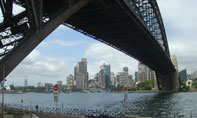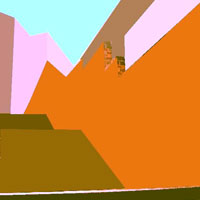- About Us
- Columns
- Letters
- Cartoons
- The Udder Limits
- Archives
- Ezy Reading Archive
- 2024 Cud Archives
- 2023 Cud Archives
- 2022 Cud Archives
- 2021 Cud Archives
- 2020 Cud Archives
- 2015-2019
- 2010-2014
- 2004-2009
 |
Bad Art in Good Times |
Life reflects Art. Art reflects life. You've heard it all before. But I don't think that when life is good, that the quality of art follows suit.
The quality and depth of Australian art is limited by our high standard of living and relatively simple culture. There are thousands of artists working in this country. Some are painting, others sculpting, designing buildings, writing screenplays, or making television and drama. Many of these are in possession of capable technique and their work is of a high, if not excellent, aesthetic standard. But within a prosperous and apathetic society, which is largely devoid of any great social upheaval, Australian art lacks the vigour to perform its duty as an effective social critic.
I recently heard a pithy piece of wisdom that helps clarify my point. It goes something like, "an intellectual makes simple things complex, whilst an artist makes complex things simple". In light of this, the greatness of an artist could be calculated, if such a thing is possible, by an ability to condense great complexity into perfect simplicity. This is a difficult thing for Australian artists to do because there is very little about our culture that is truly complex.
One of the reflexive functions of art is to critique its environment. Unfortunately for artists, Australia is a nice place. It is a nation of fair climate and vast natural resources. It has a smart population with a strong work ethic. Since Federation, the nation has prospered under sound democratic governance. Aside from Japanese air attacks in the far north and a mischievous submarine raid on Sydney Harbour during the Second World War, the devastation of modern warfare has barely visited. In war Australia has lost servicemen, which is a terrible thing, but far more palatable than losing thousands of civilians and cities to carpet bombing or nuclear fallout. Natural disasters in Australia have been few and far between, with little of the wrath that has brought other cities and nations to their knees. Australia is the seemingly innocuous friend you bring home to meet your mother.
 As with any gigantic mass of land with 20 million inhabitants, there are some problems. A decent solution to reconcile Aboriginal inequality is nowhere to be seen. Immigration policy should probably be overhauled. This also applies to Australia's foreign policy, especially concerning military commitments. There are many unresolved environmental concerns, water conservation and sustainable energy seem to be quite important topics with the power to cause profound social disturbance. And of course, the endemic ailments of the health and education systems are a given. Whilst these problems are significant in their own right, none seem to inspire, captivate or divide the population for more than the briefest period. One explanation that I can offer is that most people are largely unaffected by any of them. How many people have befriended a refugee? How many people know someone serving in Iraq? How many people have a large number of Aboriginal friends? There is a chance that there are many people who could say "yes" to all three questions, but across the population I suspect that the incidence is not very great. Unless people have a personal engagement with these issues, there is a only a slight chance that we could care less. For many, this attitude is not necessarily a reflection of implicit support of current government policy, but an apathetic sigh given in light of any viable political alternative. But back to the art!
As with any gigantic mass of land with 20 million inhabitants, there are some problems. A decent solution to reconcile Aboriginal inequality is nowhere to be seen. Immigration policy should probably be overhauled. This also applies to Australia's foreign policy, especially concerning military commitments. There are many unresolved environmental concerns, water conservation and sustainable energy seem to be quite important topics with the power to cause profound social disturbance. And of course, the endemic ailments of the health and education systems are a given. Whilst these problems are significant in their own right, none seem to inspire, captivate or divide the population for more than the briefest period. One explanation that I can offer is that most people are largely unaffected by any of them. How many people have befriended a refugee? How many people know someone serving in Iraq? How many people have a large number of Aboriginal friends? There is a chance that there are many people who could say "yes" to all three questions, but across the population I suspect that the incidence is not very great. Unless people have a personal engagement with these issues, there is a only a slight chance that we could care less. For many, this attitude is not necessarily a reflection of implicit support of current government policy, but an apathetic sigh given in light of any viable political alternative. But back to the art!
It is no small co'incidence that Aboriginal art has experienced a huge surge in both domestic and international popularity over the last decade. This rise has occurred in a culture where authentic concern for Indigenous Australia has reached a peak. We are more conscious of the social problems that affect the Aboriginal people and their rich tradition, and the essence of this is somehow distilled into more meaningful artistic expression. There is an authenticity in Aboriginal art that cannot be found in other Australian art forms which do not come from a culture of unrest and upheaval.
On the other hand, Australian painting as a whole has been relatively bland when compared with works from foreigners. The greatest Australian works of the twentieth century were produced by artists such as Sidney Nolan, Arthur Boyd, Margaret Preston, Donald Friend, Brett Whiteley, John Olsen and Robert Dickerson. Each of these artists created paintings with an undeniably Australian aura, but the sense of apathy in their work is overwhelming. With all of these painters I have felt a sense of disengagement when viewing their works, rather than any sense of inclusion in any critical process. I felt under-whelmed by the emptiness of this Australian aura, lost in khaki landscapes alongside mystic nymphs washing in water'holes. This is completely different to when I have viewed great art overseas, or great foreign art in Australia. The thrill of engaging with a Goya masterpiece is marvellous. The same could be said standing in front of Pollock's Blue Poles in Canberra. The technical expertise is no different in these examples to Australian works, but the context is a universe apart. Australian artists just don't seem to have the cultural baggage.
It comes as no surprise to me that two of Australia's finest pieces of architecture, The Sydney Opera House, and The Aurora Towers on Macquarie Street, Sydney, were designed by a foreigners. Both buildings capture and define the essence of the harbour city more capably than any of their neighbours in the Sydney skyline. Unfortunately, the vision required to build such incredible structures seems beyond the scope of local architects.
Is it possible to change this? Can society arrest such indifference? Unless Australians engage with national problems, however far removed they might be from their own individual lives, there is little chance that art in Australia can perform its function as a social critic. And while the going is good, there is little motivation for any of us to do anything except go to enjoy another art exhibition.
